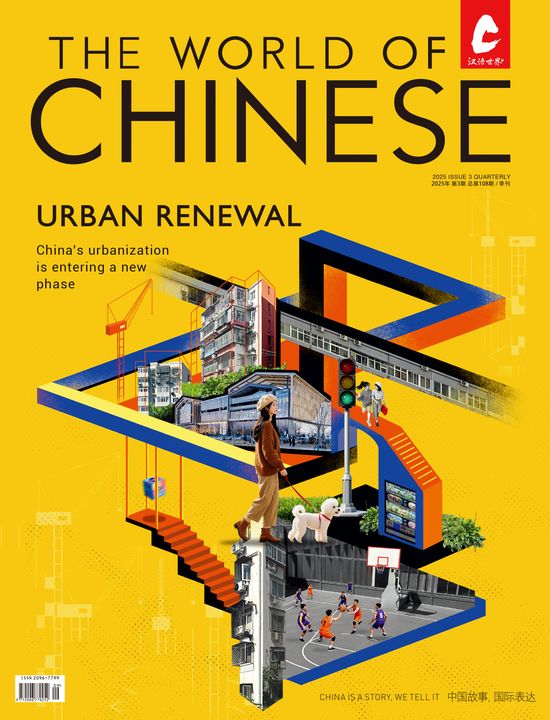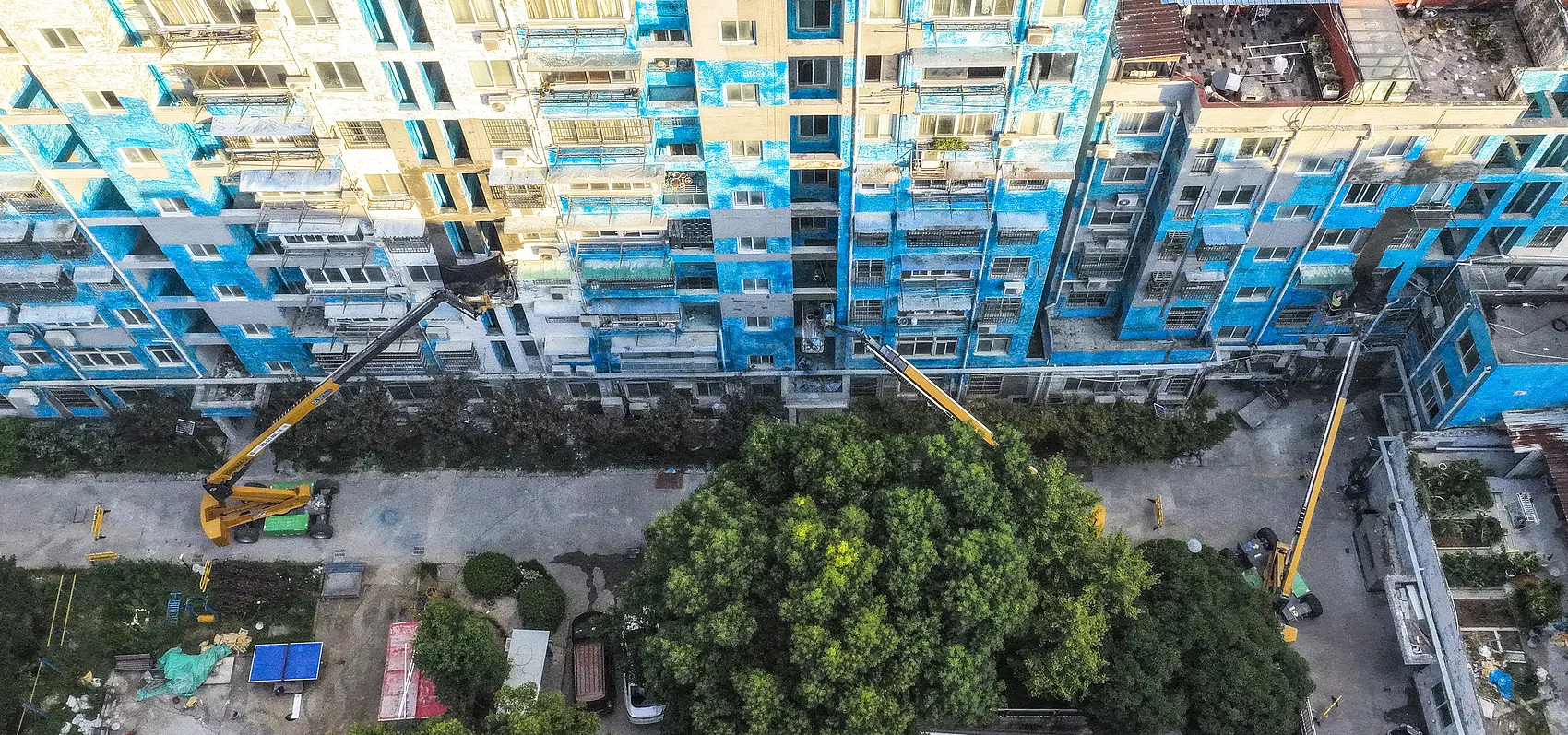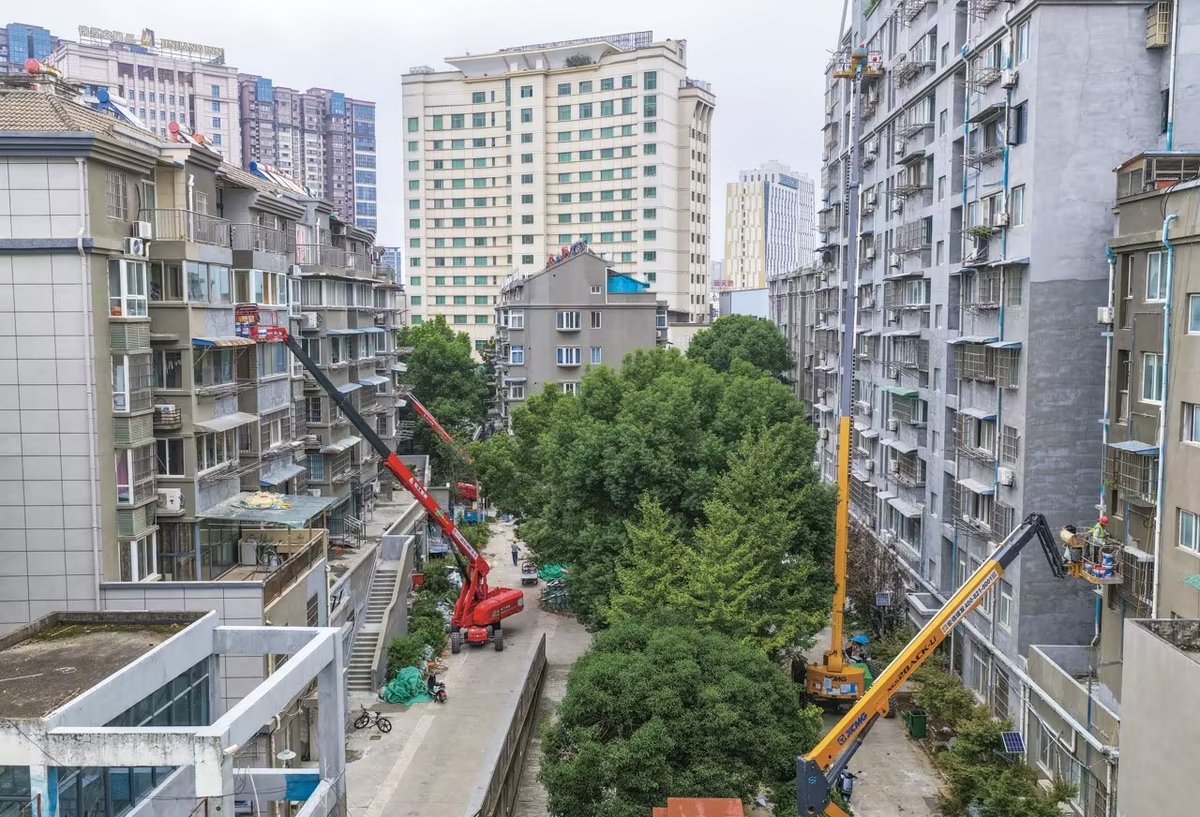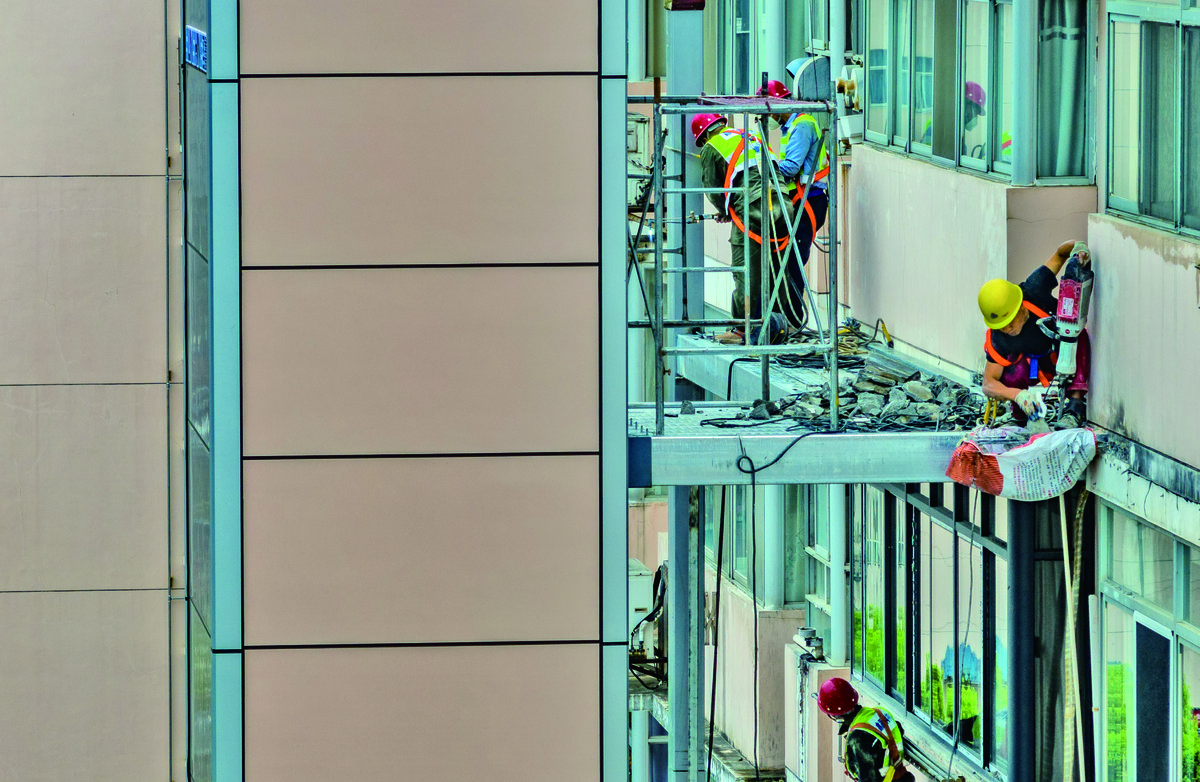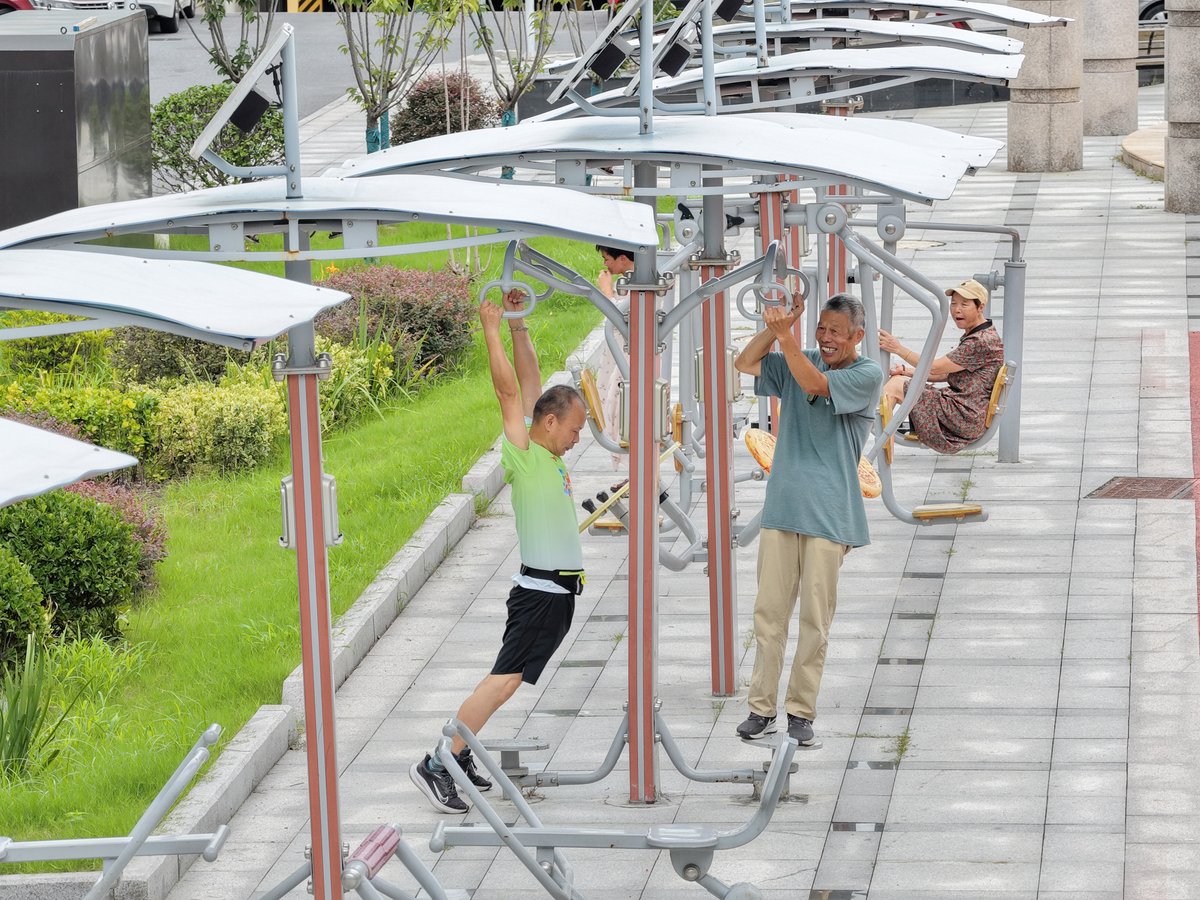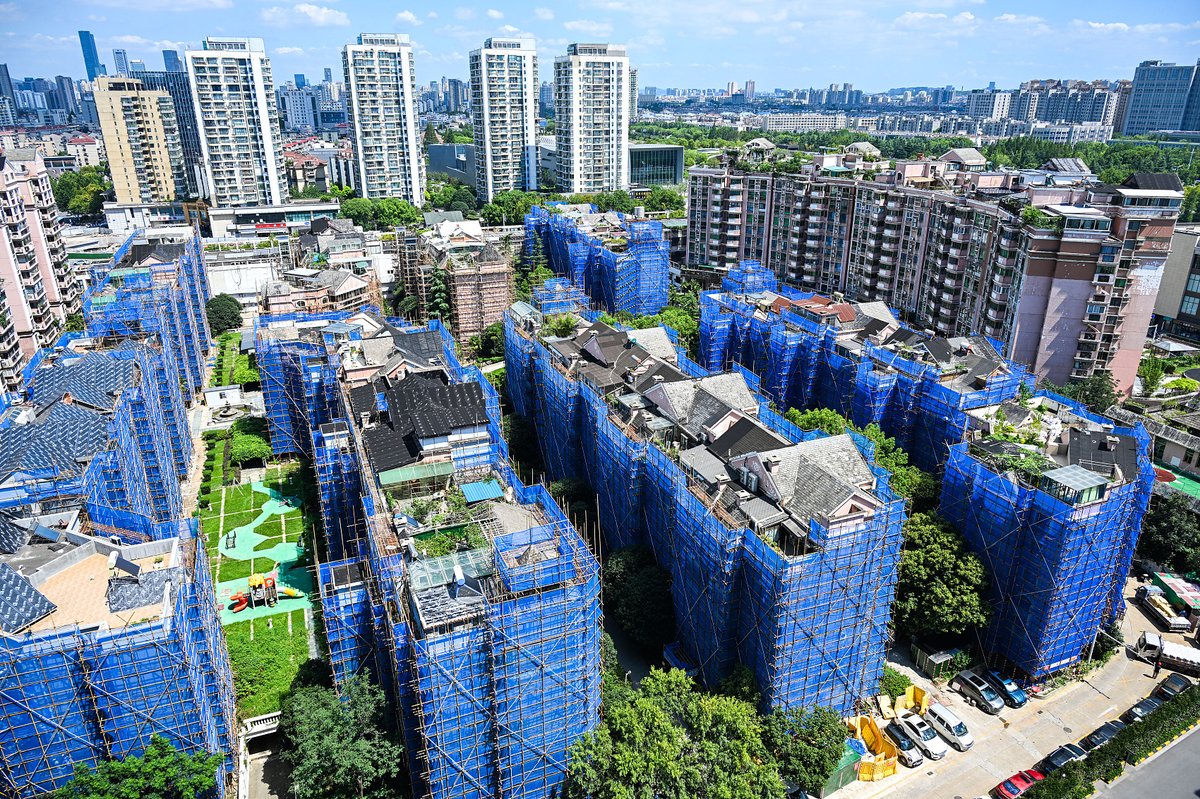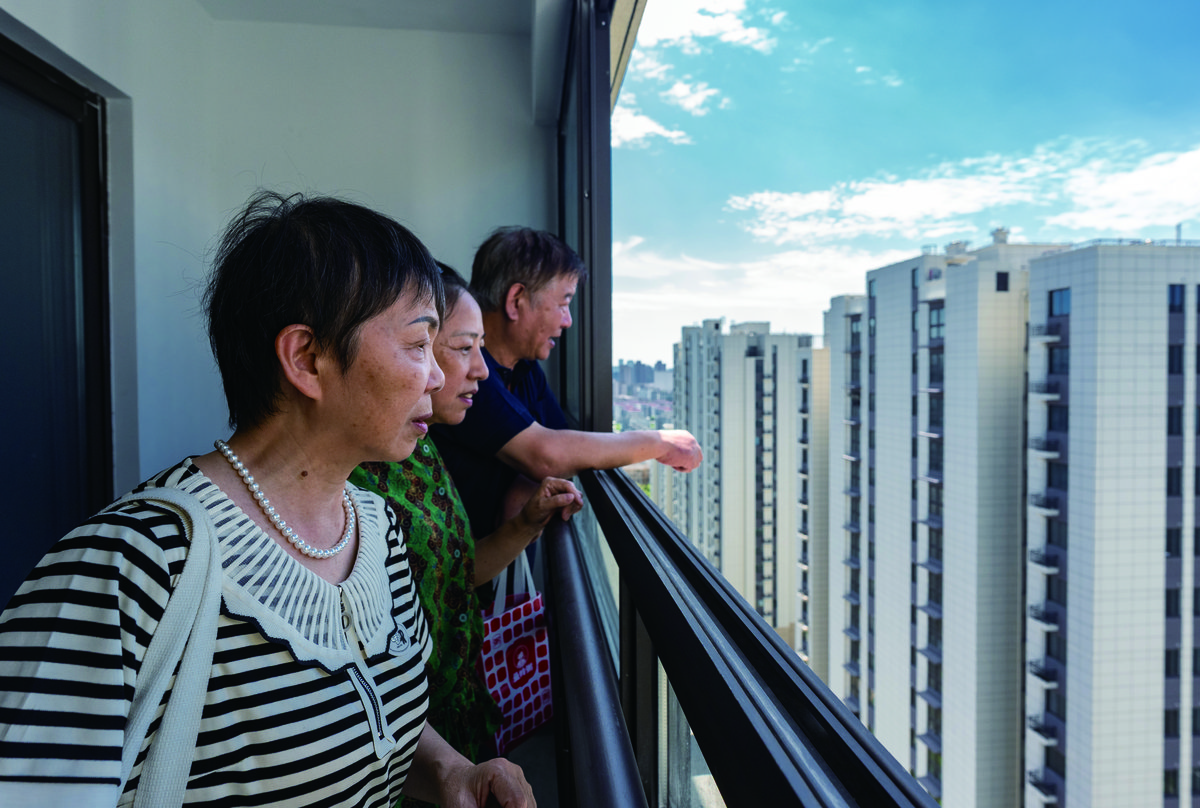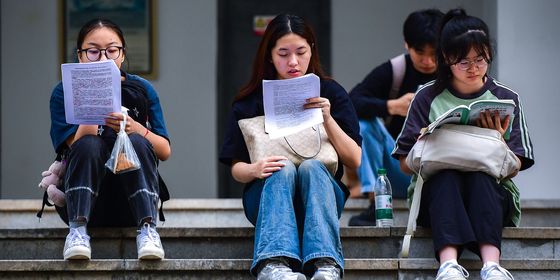Once symbols of progress, China’s residential buildings now face cracks, costs, and uncertainty
Over the past year, Gu Song has given up his habit of taking after-meal strolls around his apartment block in Beijing. “It’s all such a mess,” the career consultant in his 50s complains. “Who’s got the mood for it?”
Built in 2005, Gu’s apartment compound was advertised as a “garden villa” boasting tree-lined sidewalks and a pond. But since last April, it has more often resembled a construction site, dotted with protective nets, scaffolds, and building materials rather than flowers.
“I picked this community because it was close to my son’s school,” Gu, who agreed to be interviewed under a pseudonym, recalls. “It was also among the best properties in the neighborhood at the time.” However, signs of deterioration began to appear after a decade. Since 2018, loose tiles have been falling from exterior walls of the apartment buildings, posing a danger every windy day for the compound’s approximately 1,200 households (plus vehicles and passersby). The effort to repair the building’s exterior has become a prolonged struggle among homeowners, property management, and, later, the repair contractor, with disputes over responsibility, procedures, and cost.
Read more about China’s urbanization:
- 15-Minute City: Can It Solve Chinese Urban Sprawl?
- Seeds of Change: Transforming China’s Abandoned Urban Corners
- Industrial Evolution: Turning Old Factories into New Cultural Parks
Once an enviable symbol of urbanization and the pride of the country’s first-time homeowners, many of China’s high-rise apartment blocks are showing cracks from outdated standards, poor-quality building materials, and improper management and maintenance. As the property boom cools and funding grows scarce, homeowners, officials, and businesses are wrestling with how to finance and carry out much-needed renovations and repairs—a challenge critical to the city’s future.
A standstill over renovation and repair can have serious consequences. This August, a piece of plaster detached from an apartment building in Changsha, a southern Chinese city, killing a young woman passing underneath. The incident made national news and struck a chord with homeowners across the country, reflecting the all-too-familiar safety concerns and challenges of coordinating house repairs. According to China Central Television, the property management company of this development, built in the 2010s, had agreed to repair the building’s exterior and address ongoing water leaks, which may have caused the plaster to detach.
Large renovations like these require the company to tap into the housing maintenance fund, which is co-paid by the developer and homeowners at the time of purchase and held in trust by the local government for the upkeep, renovation, and upgrading of a building’s shared parts and facilities. Accessing these funds can take months or even years, as the process involves obtaining consent from the majority of homeowners, consulting with construction companies on project details, and securing approval from multiple government authorities, including the subdistrict office and the housing management bureau. To make matters worse, none of these steps has established precedents to follow, reflecting how recent China’s urbanization still is.
In Gu’s community, the Xin’ao Villa estate in Beijing’s Dongcheng district, the property management company, juweihui (居委会, neighborhood committee), and subdistrict office have all so far failed to offer satisfactory solutions to the loose-tile problem. The long waiting time and multiple failed proposals have also damaged residents’ trust in the company.
Residents decided to take matters into their own hands. In 2021, after months of lobbying and volunteer work by a group of determined homeowners, they formed a homeowners’ association. They successfully applied for the maintenance fund and even chose a construction company through a bidding process. This small victory drew attention: local media widely reported it as a pioneering example of a homeowners’ association making a tangible difference.
But when renovation work finally began early last year, hopeful residents encountered new hurdles. Beyond the disruptions to daily life—such as broken air-conditioning and window views blocked by safety nets—the project quickly ran over budget. By the end of the year, work had stalled: four buildings were left unfinished, with the contractor issuing an additional bill of more than 1 million yuan, while work on the remaining six buildings had yet to begin.
Since the late 1970s, China has seen the fastest urbanization rate in history. As of 2024, over 940 million Chinese live in cities, a leap from 18 percent of the total population in 1978 to 67 percent. In 1998, the welfare housing system, under which the government and state-owned enterprises allocated apartments to workers at extremely low rent or even for free, was officially abolished and replaced with a market-based system where properties could be bought and sold.
Hailing from China’s southeastern province of Jiangxi, Gu became a “new Beijinger” in the early 1990s after graduating from university and securing a job in the capital, which at the time came with allocated housing. However, the welfare apartment was small, awkwardly laid out, and poorly equipped to accommodate his growing family. By the early 2000s, when commercial housing became available and his income had risen, Gu and his family—like many urbanites—bought their first apartment outside the Third Ring Road for around 4,000 yuan per square meter, a price that has now increased nearly twentyfold.
With Xin’ao Villa as his third property, Gu has been closely following the evolution of China’s urban housing policies. “When commercial housing first appeared, many policies were not yet in place,” Gu says. “After more than 20 years of rapid growth, the real estate sector has reached a turning point—we now need a comprehensive plan.”
Chinese homebuyers are entitled to 70 years of property rights with no property tax at the moment. The national standard puts the designed service life of residential buildings at 50 years, which means that when used normally and maintained regularly, the main structure of a residential building can withstand common risks such as earthquakes, heavy rain, and normal loads.
In reality, many buildings have proven far shorter-lived than intended. Over the past 20 years, cracked or even collapsing apartments have been periodically reported. In 2014, a 20-year-old building in Fenghua, Zhejiang province, collapsed, killing one person and injuring six. The building had already been classified as a dangerous structure by a third-party inspection agency, which recommended reinforcement, but the required 4.5 million yuan in funding was not settled in time. The incident sparked a nationwide discussion on building safety, with some experts claiming that the average service life of Chinese residential buildings was closer to 30 years. A week later, the Ministry of Housing and Urban-Rural Development launched a nationwide safety inspection of old and unsafe buildings and began expediting their demolition and renovation.
In the less-regulated property sector of the 1980s and 1990s, most residential buildings were brick-timber or brick-concrete structures, rather than the reinforced concrete structures common today. Due to low building standards and incomplete regulations, construction quality was generally weak, with substandard techniques and materials creating potential safety risks. Cutting corners was widespread. In the Fenghua case, this poor-quality construction was further compounded by residents’ unauthorized renovations, such as converting windows into doors or removing load-bearing walls.
According to the latest census in 2020, over 30 percent of China’s urban housing is old residential compounds built before 2000. Besides safety issues, these old buildings also inherited their own set of challenges from the welfare era.
Feng Yanjun, an urban planner in China’s southern province of Guangdong, grew up in one such old apartment. “It’s in an old, rundown building in the city’s old district,” Feng tells TWOC. “There’s no property management—each building stands alone. So public spaces, like the staircases, aren’t maintained at all.” Feng’s mother bought this apartment in the late 1990s from her work unit at cost, a benefit offered to residents of public housing under the welfare system during the housing reform. All her family has since moved out due to the deterioration. This year, Feng listed it for sale at a reduced price, but there have been few interested buyers.
Fragmented property ownership has also made it difficult to reach a consensus on renovation and maintenance, especially since most of these old buildings lack a housing maintenance fund, which was not established until 1998.
Old residential buildings, still traded on the rental and sales market, rely on government-led renovation as a final safeguard. The demolition-and-relocation model, which has been a main approach for expanding and upgrading the city, has gradually come to a halt in recent years. “The era of continuously rising housing prices is over. If housing prices don’t keep climbing, this model cannot be sustained,” says Feng, who had previously hoped to trade their old property for new assets through government land requisition.
Widely seen as signaling a turning point in China’s urban development from expanding to upgrading, this May, the CPC Central Committee and the State Council jointly issued a series of opinions for urban renewal through 2030, with old residential buildings—defined as buildings constructed before 2000—among the top priorities.
In fact, over the past decade, many such projects have already begun, including replacing pipes and wiring, installing elevators, expanding parking, adding elderly-care and childcare services, and addressing general neglect and disrepair. Vice Minister of Housing and Urban-Rural Development Qin Haixiang shared in March that more than 280,000 residential compounds were upgraded between 2019 and 2024, benefiting 48 million households.
Undertaking a large-scale renovation in a fully occupied, densely populated residential community is never easy. Zhao, a homeowner in Beijing’s Haidian district who asked to be identified by her last name only, shared on the social media platform Xiaohongshu (RedNote) how her life was turned upside down during the two-month project. She bought her apartment 11 years ago in an old residential compound, where residents had long struggled with frequent drainage blockages, crumbling exterior walls, and other daily inconveniences. With no property management to turn to, the neighborhood committee stepped in to help apply for the government-led renovation. After three years of waiting, the project finally kicked off last September, bringing both disruption and hope for a long-overdue upgrade.
The most disruptive part of the renovation was replacing the rust-prone iron pipes with standard polyvinyl chloride ones. All bathrooms in the building were unusable for two weeks while every floor was dug up, and Zhao’s other rooms were stacked with counters, sinks, and stoves removed from the kitchen and bathroom.
“Can you imagine? Six electric drills going at the same time, the noise rising and falling nonstop,” posted Zhao. “Normally, just one household renovating is already noisy enough—but now? There’s no way you can stay indoors for even a day…”
Zhao’s post generated over 10,000 views, and the comments section was filled with homeowners living in old residential buildings sharing their renovation experiences, as well as questions from those hesitant to begin—questions that Zhao patiently addressed.
“Most residents support the renovation, though a few who had recently renovated were initially reluctant due to the additional costs and repairs required,” Zhao tells TWOC. “After seeing severely corroded pipes in neighboring units, they recognized the need for action and agreed to proceed.” Zhao believes the renovation has produced positive results despite some minor issues, but also notes that its quality and effectiveness largely depend on the contractor’s capability, and conditions vary across districts.
Since 2000, China’s rapid urban development has fueled a booming real estate sector, creating new challenges in managing residential buildings today. In response to the 2008 global financial crisis, government measures, such as land sales and homebuyer loans, supported the property market, prompting developers to expand rapidly. In the rush for profit, many developers compromised on construction quality, which has substantially increased both the difficulty and cost of maintaining residential buildings.
Moreover, property management companies are often affiliated with the developer, which does little to inspire confidence when buildings are flawed from the start. In the case of Xin’ao Villa, Tian Zhi, another owner in the compound, criticizes their property management company. “Our property management has long maintained a rather strong-handed presence in the community,” says the 47-year-old overseas business development manager. “Beyond providing services, they have overstepped by acting as if representing residents’ interests.” Tian and other residents believe the company is ineffective in maintaining the compound while overcharging for repairs, prompting the owners to take action by forming a homeowners’ committee—an arduous journey in itself. “It did take a lot of effort…to knock on neighbors’ doors, and call those who rented out their apartments, live in other cities, or even abroad,” Tian recalls of his work in canvassing votes.
When the news came that the repair project had halted due to an initial error in cost assessment and a general lack of professional supervision, it was shocking. But to Tian, who hasn’t been involved in the committee since its establishment, the deeper reasons behind it are also clear: The association’s volunteers, some of whom were retirees, had to coordinate with the subdistrict office and construction company, mostly at their own expense.
Tian suggests that the homeowners’ committee adopt a professional manager model, “with a clear salary structure.” He also emphasizes that the relationship between the committee and the local government should be integrated into the government’s grassroots management as part of its administrative responsibilities. “With the aging population increasing, the government cannot possibly invest heavily in renovating all residential compounds,” Tian, who was a former policy researcher, says. “It will have to be self-sufficient and self-reliant.”
Regarding the future of aging residential properties, there have also been pioneering cases of on-site reconstruction, jointly financed by owners, private developers, and government subsidies. Notable examples include Zhegong New Village in Hangzhou and Shanghai’s Pengyi Compound. In these projects, residents pay well below market prices while receiving more spacious apartments with upgraded facilities. Meanwhile, private developers gain the right to manage and lease commercial spaces within the compounds.
For the next generation of homebuyers, the landscape will be different, too. In March of this year, China’s State Council indicated that the real estate sector should shift its focus to building “high-quality homes,” emphasizing safety, amenities, environmental friendliness, and smart technology. Since May, new construction in China must meet stricter standards for sound insulation, natural lighting, and ventilation, while also adhering to a minimum floor height of three meters and requiring elevators in any building of four stories or more.
At the time of writing, the homeowners of Xin’ao Villa remain in a frustrating limbo—still negotiating with the current contractor in the hope they’ll complete the work already underway, while simultaneously trying to find a new company to handle the remaining tasks. The difficulties this community encounters, and how it continues to tackle them with persistence, are a microcosm of China’s urbanization process.
How Residential Renovation Became China’s New Urban Battleground is a story from our issue, “Urban Renewal.” To read the entire issue, become a subscriber and receive the full magazine.
